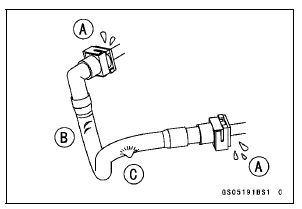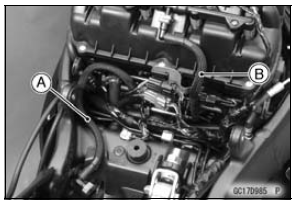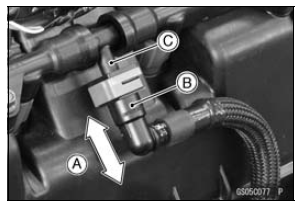

Replace the fuel hose if any fraying, cracks [B] or bulges [C] are noticed.

Replace the hose if it has been sharply bent or kinked.

Push and pull [A] the fuel hose joint [B] back and forth more than two times, and make sure it is locked.
Check the other hose joint in the same way.

NOTICE
When pushing and pulling the fuel hose joint, do not apply strong force to the delivery pipe [C] on the nozzle assy. The pipe made from resin could be damaged.
| WARNING Leaking fuel can cause a fire or explosion resulting in serious burns. Make sure the hose joint is installed correctly on the delivery pipe by sliding the joint. |
If it does not locked, reinstall the hose joint.
 Idle Speed Inspection
Idle Speed Inspection Evaporative Emission Control System Inspection (CAL and SEA-B1 Models)
Evaporative Emission Control System Inspection (CAL and SEA-B1 Models)Valve Clearance Adjustment
To change the valve clearance, remove the camshafts
(see Camshaft Removal in the Engine Top End chapter)
and valve lifters.
Replace the shim with one of a different thickness.
NOTE
Mark and record the locations of the valve lifters and
shims so that they can be reinstalled in their ...
CAN Communication (Transmission)/CAN Bus OFF Monitor Inspection (Service Code
b 57) CAN Communication (Reception) Monitor Inspection (Service Code b 58)
Remove:
Seat (see Seat Removal in the Frame chapter)
Immobilizer (Equipped Models)/Kawasaki Diagnostic
System Connector Cap [A]
Measure the CAN communication line resistance.
Immobilizer (Equipped Models)/Kawasaki Diagnostic
System Connector [A]
GY/BL Terminal [B]
LB Ter ...
Crankshaft Sensor Peak Voltage Inspection
Refer to the Crankshaft Sensor Peak Voltage Inspection
in the Electrical System chapter.
If the reading is within the standard, remove the ECU and
check the wiring for continuity between harness connectors.
Special Tool - Hand Tester: 57001-1394
Disconnect the ECU and sensor connector ...